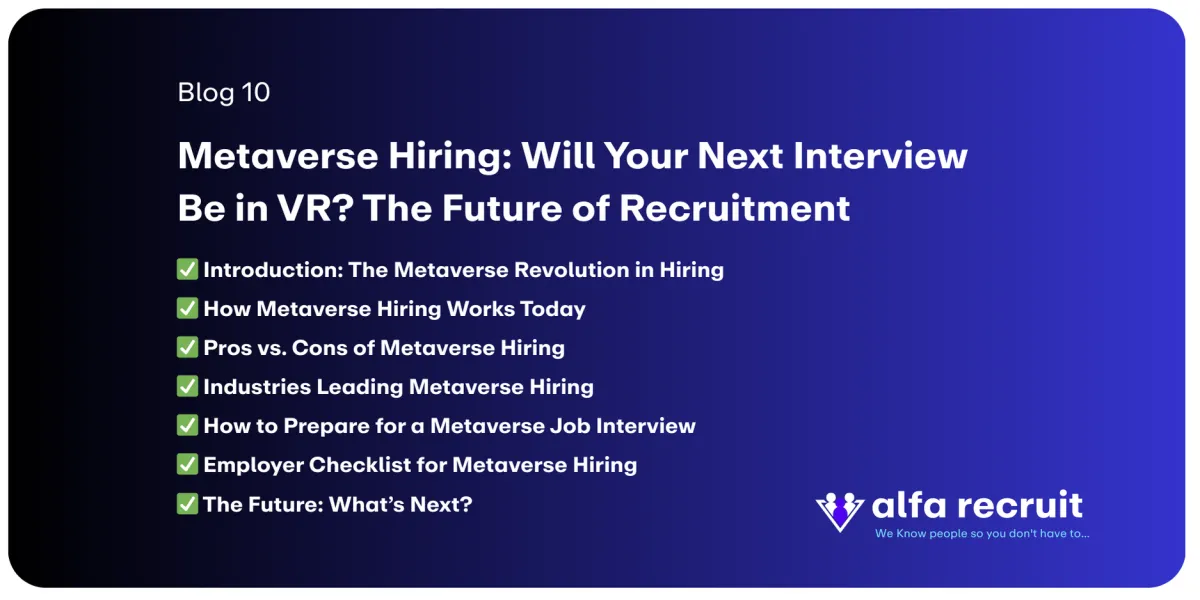
Metaverse Hiring: Will Your Next Interview Be in VR? The Future of Recruitment
🚀 Introduction: The Future of Recruitment is Here
Picture this: You put on a VR headset and suddenly, you’re shaking hands with your interviewer in a virtual office overlooking a digital cityscape. No travel, no awkward Zoom delays—just a hyper-realistic, immersive interview experience.
This isn’t sci-fi. Companies like Accenture, JP Morgan, and Microsoft are already using the metaverse for hiring.
📊 By the Numbers:
25% of Fortune 500 companies will have metaverse hiring programs by 2025 (Gartner)
Virtual interviews reduce hiring bias by 35% (PwC)
70% of Gen Z candidates prefer VR interviews over phone screens (Deloitte)
But is this just a gimmick, or the next evolution of recruitment?
In this guide, we’ll break down:
✅ What is Metaverse Hiring?
✅ Pros vs. ❌ Cons of Metaverse Hiring
✅ Industries Leading Metaverse Hiring
✅ How to prepare for a metaverse job interview
✅ Employer Checklist for Metaverse Hiring
✅ The Future: What’s Next?
Let’s dive in.
🌐 What is Metaverse Hiring?
The Basics:
Metaverse hiring uses virtual reality (VR) or augmented reality (AR) to:
✔ Conduct immersive job interviews
✔ Host virtual career fairs
✔ Simulate real-world job tasks (e.g., coding in a VR workspace)
Key Technologies Powering This Trend:
💡 Example: Accenture onboarded 150,000+ employees in the metaverse, including VR training simulations.
✅ The Pros: Why Companies Are Adopting VR Hiring
✔️ Better Skills Assessment
Hands-on simulations: Engineers fix 3D machinery, salespeople pitch to virtual clients.
Soft skills testing: Body language and collaboration in shared spaces.
✔️ Global Talent Access
Interview candidates worldwide without travel costs.
Overcome visa limitations for international roles.
✔️ Enhanced Employer Branding
Tech-forward companies attract Gen Z and digital-native talent.
Virtual office tours > PDF brochures.
✔️ Reduced Unconscious Bias
Avatar-based interviews mask gender, race, and age (optional).
Structured VR assessments standardize evaluations.
📌 Stats:
64% of candidates say VR interviews feel more engaging than Zoom (PwC).
VR training improves knowledge retention by 75% vs. traditional methods.
❌ The Cons: Challenges of Metaverse Recruitment
❌ High Tech Barriers
Cost: $1,500+ per VR setup for employers/candidates.
42% of professionals report VR motion sickness (Stanford Study).
❌ Accessibility Gaps
Only 8% of global companies currently have metaverse capabilities.
Risks excluding non-tech talent (e.g., manufacturing, healthcare).
❌ Privacy & Security Risks
Data tracking in VR: Eye movements, voice stress, even posture could be analyzed.
No legal frameworks for metaverse discrimination claims.
🔴 Red Flag: A Fortune 500 company scrapped VR hiring after candidates refused to share biometric data.
🏆 Industries Leading Metaverse Hiring
📌 Why It Works:
Saves time & travel costs
Tests skills in real-world simulations
Attracts tech-savvy Gen Z talent
How to Prepare for a Metaverse Interview (Candidate Guide)
🛠️ Technical Setup
Test your VR headset, internet speed, and avatar beforehand.
Download the employer’s preferred platform (e.g., Spatial, Engage).
🎯 Interview Tips
Practice nonverbal cues: Eye contact, hand gestures.
Use the environment: Whiteboard ideas in 3D space.
Dress your avatar professionally (yes, it matters).
🚫 What to Avoid
Over-animated movements (can trigger motion sickness).
Ignoring VR etiquette (e.g., virtual personal space).
Employer Checklist for Metaverse Hiring
✅ Start Small
Pilot VR for high-volume roles (customer service, IT support).
✅ Choose the Right Platform
Horizon Workrooms (Meta) for collaboration.
Virbela for virtual career fairs.
✅ Train Your Team
HR must master VR moderation tools (muting, screen sharing).
Set clear evaluation criteria for VR assessments.
✅ Ensure Inclusivity
Offer non-VR alternatives (e.g., Zoom).
Subsidize headsets for underrepresented candidates.
🔮 The Future: What’s Next?
2024: 30% of tech startups adopt VR interviews
2025: AI-powered VR interview coaches become mainstream
2026: Governments regulate metaverse hiring discrimination policies
🚀 Key Takeaway: Metaverse hiring is more than a trend—it’s a fundamental shift toward skills-based, immersive assessments.
Conclusion: Adapt or Get Left Behind
Metaverse hiring isn’t replacing traditional methods—it’s adding a powerful new dimension. Companies that adopt early will:
🚀 Attract top digital-native talent
💡 Assess skills more accurately
🌍 Build truly global teams
📢 Need a hiring partner that balances tech and human touch? Talk to our experts today.- https://alfarecruit.com/calendar
❓ Metaverse Hiring FAQs
1. Will VR replace in-person interviews?
Not entirely—but it will become a standard first-round screening tool, especially for remote roles.
2. What industries use metaverse hiring most?
Tech (software engineering, VR development)
Gaming (design, QA testing)
Retail (virtual store training)
Consulting (client simulations)
3. Can you cheat in a VR interview?
Harder than Zoom! Eye-tracking and real-time tasks make it tough to fake skills.
4. Is metaverse hiring expensive for candidates?
Some companies loan headsets or use browser-based VR (no equipment needed).
Metaverse Hiring: Will Your Next Interview Be in VR? The Future of Recruitment
🚀 Introduction: The Future of Recruitment is Here
Key Technologies Powering This Trend:
✅ The Pros: Why Companies Are Adopting VR Hiring
❌ The Cons: Challenges of Metaverse Recruitment
🏆 Industries Leading Metaverse Hiring
How to Prepare for a Metaverse Interview (Candidate Guide)
Employer Checklist for Metaverse Hiring
Conclusion: Adapt or Get Left Behind
1. Will VR replace in-person interviews?
2. What industries use metaverse hiring most?
3. Can you cheat in a VR interview?
4. Is metaverse hiring expensive for candidates?
